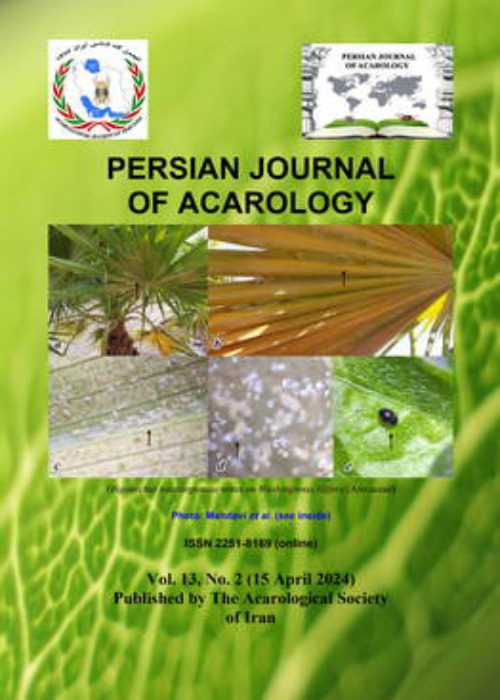Almond spider mite, Schizotetranychus smirnovi (Acari: Tetranychidae): population parameters in laboratory and field conditions
Schizotetranychus smirnovi Wainstein is a serious pest of almond in Iran and its population has extremely increased recently in Chaharmahal va Bakhtiari province. Biological parameters of this mitewere determined on almond leaves (Mamaei variety), under laboratory conditions at 27.5 ± 1 °C, 50 ± 10 % RH, and photoperiod of 14:10 (L:D). More-over, population fluctuation of S. smirnovi and its predator, Scolothrips longicornis Priesner, were studied on almond (Mamaei c.v.) under field conditions (from April to October) during two successive years 2008–2009. Laboratory results showed that egg incubation period is the longest (3.25 ± 0.25 and 3.05 ± 0.25 days for female and male, respectively) in the immature stage. In addition, the female total immature period (2.91 ± 0.43 days) is longer than the male (2.87 ± 0.64 days). Female and male longevity were calculated as 13.20 ± 1.10 and 9.25 ± 0.75 days, respectively. Mean fecundity of the mite was calculated as 58.13 ± 6.60 eggs/female. Field studies showed that the mite overwintered as eggs around the buds of almond shoots. Overwintering eggs hatched depending on the climate conditions from the third decade of March (in 2008) to the third decade of April (in 2009). In both years, mite population continuously increased and reached to a maximum density during June and July. According to total degree-days the mite could produce 12–14 generations per year under field conditions. In addition, S. longicornis showed a strong response (F1,25 = 20.58, r = 0.69, P = 0.0001) to the S. smirnovi fluctuations; population of the mite and predatory thrips fluctuated simultaneously. Our findings may provide practical information about the seasonal abundance of S. simrnovi and be useful for agricultural experts and farmers to develop a successful integrated pest management (IPM) program.
پرداخت حق اشتراک به معنای پذیرش "شرایط خدمات" پایگاه مگیران از سوی شماست.
اگر عضو مگیران هستید:
اگر مقاله ای از شما در مگیران نمایه شده، برای استفاده از اعتبار اهدایی سامانه نویسندگان با ایمیل منتشرشده ثبت نام کنید. ثبت نام
- حق عضویت دریافتی صرف حمایت از نشریات عضو و نگهداری، تکمیل و توسعه مگیران میشود.
- پرداخت حق اشتراک و دانلود مقالات اجازه بازنشر آن در سایر رسانههای چاپی و دیجیتال را به کاربر نمیدهد.


